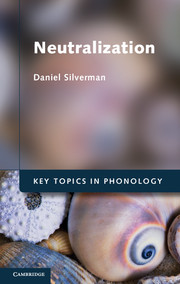Book contents
- Frontmatter
- Contents
- List of Figures
- Preface
- Acknowledgments
- 1 The rhyme and the reason of neutralization
- Part I Rhyme
- Section A Observation and description
- Section B False positives
- Section C Explanation
- 7 Ease of production
- 8 Ease of perception
- 9 Phonetic misperception
- 10 Semantic misperception: early proposals
- 11 Semantic misperception: recent proposals
- Section D Exemplification
- Part II Reason
- Glossary
- References
- Language index
- Subject index
10 - Semantic misperception: early proposals
Published online by Cambridge University Press: 05 November 2012
- Frontmatter
- Contents
- List of Figures
- Preface
- Acknowledgments
- 1 The rhyme and the reason of neutralization
- Part I Rhyme
- Section A Observation and description
- Section B False positives
- Section C Explanation
- 7 Ease of production
- 8 Ease of perception
- 9 Phonetic misperception
- 10 Semantic misperception: early proposals
- 11 Semantic misperception: recent proposals
- Section D Exemplification
- Part II Reason
- Glossary
- References
- Language index
- Subject index
Summary
Having now considered Ohala's listener-based approach to neutralization – one rooted in the proposal that listeners may sporadically misinterpret speakers' phonetic intentions – in this chapter we move on to consider an alternative listener-based approach to the issue, one rooted in the proposal that listeners may sporadically misinterpret speakers' semantic intentions. On the face of it, this may seem a bizarre claim indeed, so the goal here is to build arguments in its favor, considering Martinet's (1952) proposals on sound change and functional load, as well as King's (1967) rejoinder.
MARTINET (1952)
Martinet (1952) starts from the validated assertion that speech is inherently variable in terms of its articulatory and acoustic properties. This variability is not only due to context-sensitive factors (that is, due to what he calls “allophonic deviations”), but also in a context-free sense. He argues that this low-level phonetic variation, generally speaking, is passively delimited such that a comfortable perceptual buffer zone is maintained between one value and its immediate systemic neighbors. However, Martinet notes that, under certain circumstances, this buffer zone may be fatally breached such that one value may (diachronically) merge or (synchronically) neutralize with another. Thus, while each value (in each context) has a “center of [acoustic and articulatory] gravity”, there is likely to be sufficient low-level variation such that tokens of one value, a, might occasionally stray into the territory of a neighboring value, b. Under some conditions, such strays are tolerated, since the movement of a towards b is accompanied by a movement of b towards a new value, c. This constitutes a chain shift. But on other occasions, merger or neutralization of a and b does indeed take place. The question that Martinet contends with is this: What pressures exist on the phonological system to limit the likelihood of one value merging or neutralizing with another value?
- Type
- Chapter
- Information
- Neutralization , pp. 110 - 118Publisher: Cambridge University PressPrint publication year: 2012



